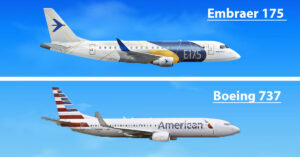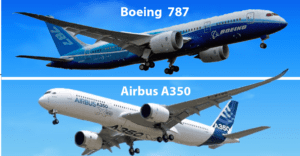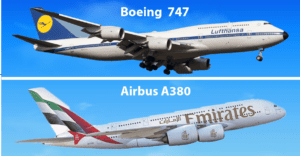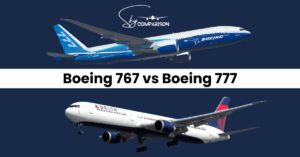Boeing 767 vs Boeing 737 A Closer Look at Aviation Giants
Boeing 767 vs Boeing 737, The 767 variants are longer, heavier, and have greater wingspans than all 737 variants. Boeing 767 generally has more power than a Boeing 737. If the 767 fills up with full fuel, then it’d be heavier and take up more runway. But there are a few similarities.
Boeing 767 vs Boeing 737
When comparing the Boeing 767 vs Boeing 737, there are some key differences to note. The 767 is generally larger than the 737, with varying models having lengths ranging from around 159 to 201 feet, while the 737 typically ranges from about 100 to 119 feet in length. In terms of passenger capacity, the 767 can accommodate more travelers, with capacities ranging from approximately 181 to 245 passengers, compared to the 737, which usually seats between 115 and 146 passengers. Additionally, the 767 generally has a higher maximum takeoff weight, ranging from approximately 395,000 to 450,000 pounds, whereas the 737’s maximum takeoff weight is typically between 129,000 and 150,000 pounds.
Check out our comparison Boeing 767 vs 787 of the to see how they differ from each other.

These differences translate into varying capabilities in terms of range and performance. For instance, the 767 can cover longer distances, with ranges spanning from about 2,268 to 6,588 nautical miles, whereas the 737 usually has shorter ranges, ranging from approximately 2,079 to 5,645 nautical miles. Furthermore, the 767 tends to have higher cruise speeds, typically around Mach 0.8, compared to the 737, which usually cruises at around Mach 0.73. Overall, while both aircraft serve different needs and routes, the 767 is generally favored for longer flights with more passengers, while the 737 is often used for shorter routes with fewer travelers.
Summary
The Boeing 767 is a larger, more powerful, and more expensive aircraft than the Boeing 737. It has a longer range and can carry more passengers. The Boeing 767 also has a number of features that are not available on the Boeing 737, such as a glass cockpit and a wider fuselage.
Boeing 737
The Boeing 737 MAX 10 is a modern and efficient aircraft designed to meet the demands of today’s air travel. With a length of approximately 143 feet and a wingspan of around 117 feet, it offers ample space for passengers and cargo. The MAX 10 has a wing area of about 1,367 square feet and a height of approximately 40 feet, providing stability and aerodynamic performance. Powered by two engines with a thrust of 130 kN each, totaling 260 kN, it can handle various flight conditions with ease. With a maximum takeoff weight of around 203,000 pounds, the MAX 10 is capable of carrying up to 204 passengers in a standard three-class layout. Its impressive range of about 3,299 nautical miles allows it to connect cities across continents. With a cruise speed of Mach 0.79, the 737 MAX 10 offers a smooth and comfortable journey for passengers while maintaining efficiency and reliability. Overall, the Boeing 737 MAX 10 is a versatile and capable aircraft that continues to set new standards in the aviation industry.
Boeing 737 Variants
| Boeing 737 Variant | Description |
|---|---|
| Boeing 737-100 | Initial variant of the 737 series. |
| Boeing 737-200 | Improved version with higher seating capacity. |
| Boeing 737-300 | Increased seating capacity and range compared to 737-200. |
| Boeing 737-400 | Further improved version with longer range. |
| Boeing 737-500 | Shorter variant with reduced seating capacity. |
| Boeing 737-600 | Newest and smallest member of the 737 family. |
| Boeing 737-700 | Next generation of the 737, offering increased range and efficiency. |
| Boeing 737-800 | Longer version of the 737-700 with improved range. |
| Boeing 737-900 | Stretched variant with increased seating capacity. |
| Boeing 737-900ER | Enhanced version of the 737-900 with extended range. |
| Boeing 737 MAX 7 | Latest iteration of the 737 series with improved fuel efficiency. |
| Boeing 737 MAX 8 | Upgraded version with improved aerodynamics and fuel efficiency. |
| Boeing 737 MAX 9 | Stretched variant of the MAX 8, offering increased capacity. |
| Boeing 737 MAX 10 | Largest variant of the 737 MAX series, offering maximum seating capacity. |
Boeing 767
The Boeing 767 is a type of airplane made by Boeing, a big company that makes planes. It’s a popular choice for airlines around the world because it can carry a good number of passengers and travel long distances without stopping. The 767 has been around for quite a while, and over the years, Boeing has made different versions of it, like the 767-200 and the 767-300. Some versions have special features, like being able to carry more cargo or fly for longer distances without needing to refuel. Overall, the Boeing 767 is a reliable and versatile plane that helps people travel to different places safely and comfortably.
Boeing 767 Variants
| Boeing 767 Variant | Description |
|---|---|
| Boeing 767-200 | Standard version of the 767. |
| Boeing 767-200ER | Extended Range version of the 767. |
| Boeing 767-200SF | Special Freighter version of the 767. |
| Boeing 767-300 | Lengthened version of the 767. |
| Boeing 767-300ER | Extended Range version of the 767-300. |
| Boeing 767-300F | Freighter version of the 767-300. |
| Boeing 767-300ERF | Extended Range Freighter version of the 767-300. |
| Boeing 767-300ER BCF | Boeing Converted Freighter version of the 767-300ER. |
| Boeing 767-400ER | Extended Range version with increased passenger capacity. |
| Boeing KC-767 | Military Tanker Variant of the 767. |
| Boeing E-767 | Airborne Early Warning and Control Variant of the 767. |
| Boeing E-767A | Japanese Air Self-Defense Force AWACS Variant of the 767. |
Boeing 767-200ER vs Boeing 737-200

The Boeing 767-200ER and the Boeing 737-200 are both popular airplanes, but they have some key differences. The 767-200ER is larger, with a length of about 159 feet and a wingspan of around 156 feet. It can carry up to 181 passengers and has a maximum takeoff weight of 395,000 pounds. With a cruise speed of Mach 0.8, it can cover a range of about 6,588 nautical miles. In comparison, the 737-200 is smaller, with a length of approximately 100 feet and a wingspan of about 93 feet. It can carry up to 115 passengers and has a maximum takeoff weight of 129,000 pounds. With a cruise speed of Mach 0.73, it has a range of approximately 2,268 nautical miles. So, while the 767-200ER is larger and can travel farther with more passengers, the 737-200 is smaller and better suited for shorter flights with fewer passengers.
| Aspect | Boeing 767-200ER | Boeing 737-200 |
|---|---|---|
| Length | 48.50 m (159 ft 1 in) | 30.53 m (100 ft 2 in) |
| Wingspan | 47.60 m (156 ft 2 in) | 28.35 m (93 ft) |
| Wing Area | 283.30 m² (3,049 ft²) | 91.10 m² (981 ft²) |
| Height | 15.80 m (51 ft 10 in) | 11.29 m (37 ft) |
| Engines | 2 | 2 |
| Thrust per Engine | 282 kN (63,300 lbf) | 77 kN (17,400 lbf) |
| Total Thrust | 564 kN (126,600 lbf) | 154 kN (34,800 lbf) |
| Maximum Takeoff Weight | 179,100 kg (395,000 lbs) | 58,740 kg (129,000 lbs) |
| Range | 12,200 km (6,588 nm) | 4,200 km (2,268 nm) |
| Cruise Speed | Mach 0.8 | Mach 0.73 |
| Passenger Capacity | 181 passengers | 115 passengers |
Boeing 767-300ER vs Boeing 737-300

When it comes to comparing the Boeing 767-300ER vs Boeing 737-300, there are some noticeable differences. The 767-300ER is bigger, measuring about 180 feet long with a wingspan of 156 feet. It can carry up to 218 passengers and has a maximum takeoff weight of around 412,000 pounds. With a cruise speed of Mach 0.8, it can cover a range of approximately 6,102 nautical miles. On the other hand, the 737-300 is smaller, with a length of about 109 feet and a wingspan of 94 feet. It has a passenger capacity of 128 and a maximum takeoff weight of 138,000 pounds. Its cruise speed is Mach 0.73, and it has a range of roughly 2,700 nautical miles. So, while the 767-300ER is larger and can carry more passengers over longer distances, the 737-300 is smaller and more suited for shorter flights with fewer passengers.
| Aspect | Boeing 767-300ER | Boeing 737-300 |
|---|---|---|
| Length | 54.90 m (180 ft 1 in) | 33.40 m (109 ft 7 in) |
| Wingspan | 47.60 m (156 ft 2 in) | 28.88 m (94 ft 9 in) |
| Wing Area | 283.30 m² (3,049 ft²) | 105.40 m² (1,135 ft²) |
| Height | 15.80 m (51 ft 10 in) | 11.13 m (36 ft 6 in) |
| Engines | 2 | 2 |
| Thrust per Engine | 282 kN (63,300 lbf) | 98 kN (22,000 lbf) |
| Total Thrust | 564 kN (126,600 lbf) | 196 kN (44,000 lbf) |
| Maximum Takeoff Weight | 186,680 kg (412,000 lbs) | 62,800 kg (138,000 lbs) |
| Range | 11,300 km (6,102 nm) | 5,000 km (2,700 nm) |
| Cruise Speed | Mach 0.8 | Mach 0.73 |
| Passenger Capacity | 218 passengers | 128 passengers |
Boeing 767-400ER vs Boeing 737-400

When comparing the Boeing 767-400ER vs Boeing 737-400, there are some notable differences. The 767-400ER is larger, measuring about 201 feet long with a wingspan of 170 feet. It can carry up to 245 passengers and has a maximum takeoff weight of around 450,000 pounds. With a cruise speed of Mach 0.8, it can cover a range of approximately 5,645 nautical miles. On the other hand, the 737-400 is smaller, with a length of about 119 feet and a wingspan of 94 feet. It has a passenger capacity of 146 and a maximum takeoff weight of 150,000 pounds. Its cruise speed is Mach 0.73, and it has a range of roughly 2,079 nautical miles. So, while the 767-400ER is larger and can carry more passengers over longer distances, the 737-400 is smaller and more suited for shorter flights with fewer passengers.
| Aspect | Boeing 767-400ER | Boeing 737-400 |
|---|---|---|
| Length | 61.40 m (201 ft 5 in) | 36.45 m (119 ft 7 in) |
| Wingspan | 51.90 m (170 ft 3 in) | 28.88 m (94 ft 9 in) |
| Wing Area | 291.00 m² (3,132 ft²) | 105.40 m² (1,135 ft²) |
| Height | 16.80 m (55 ft 1 in) | 11.13 m (36 ft 6 in) |
| Engines | 2 | 2 |
| Thrust per Engine | 282 kN (63,500 lbf) | 105 kN (23,500 lbf) |
| Total Thrust | 564 kN (127,000 lbf) | 210 kN (47,000 lbf) |
| Maximum Takeoff Weight | 204,120 kg (450,000 lbs) | 68,000 kg (150,000 lbs) |
| Range | 10,454 km (5,645 nm) | 3,850 km (2,079 nm) |
| Cruise Speed | Mach 0.8 | Mach 0.73 |
| Passenger Capacity | 245 passengers | 146 passengers |
Boeing 767 vs 737 Main Differences
The main differences between the Boeing 767 and the Boeing 737 are quite noticeable. The Boeing 767 is bigger and stronger compared to the Boeing 737. It’s also more costly because it can carry more passengers and fly longer distances without needing to stop. Another thing is that the Boeing 767 has some extra features that the Boeing 737 doesn’t have, like a fancy glass cockpit and a wider body. So, while both planes are good for flying, the 767 is generally seen as a more capable and advanced option compared to the 737.
1. Boeing 767 vs 737 Engines

The main difference between the engines of the Boeing 767 vs Boeing 737 lies in their power and performance. The Boeing 767 typically uses engines with significantly higher thrust compared to those of the Boeing 737. For instance, while the Boeing 767’s engines can generate thrust of around 63,500 to 127,000 pounds, the Boeing 737’s engines usually produce thrust ranging from 17,400 to 58,634 pounds. This means that the engines of the Boeing 767 are more powerful, allowing it to carry heavier loads and fly longer distances. Additionally, the Boeing 767 may have more engine options available, providing airlines with greater flexibility to choose engines that best suit their needs.
2. Boeing 767 vs 737 Fuel
The main difference between the fuel capacities of the Boeing 767 vs Boeing 737 lies in their sizes and ranges. Generally, due to its larger size and longer range capabilities, the Boeing 767 typically has a higher fuel capacity compared to the Boeing 737. For example, the Boeing 767 can carry significantly more fuel, often ranging from around 91,000 to 202,000 liters (or approximately 24,000 to 53,000 gallons), while the Boeing 737’s fuel capacity typically ranges from around 18,000 to 44,000 liters (or approximately 4,700 to 11,600 gallons). This allows the Boeing 767 to fly longer distances without needing to refuel, making it ideal for transcontinental or international flights where fuel efficiency and endurance are crucial. Additionally, the Boeing 767’s larger fuel capacity may contribute to its ability to carry more passengers and cargo over extended distances compared to the Boeing 737.
3. Boeing 767 vs 737 Capacity
The main difference between the capacity of the Boeing 767 and the Boeing 737 lies in their sizes and passenger-carrying capabilities. Generally, the Boeing 767 is larger and can accommodate more passengers compared to the Boeing 737. For example, the Boeing 767 typically has a seating capacity ranging from around 181 to 245 passengers, whereas the Boeing 737 usually seats between 115 to 204 passengers, depending on the variant. This means that the Boeing 767 is better suited for flights requiring higher passenger volumes, such as long-haul or international routes, while the Boeing 737 is often used for shorter, domestic flights with fewer passengers. Additionally, the Boeing 767 may offer more cabin space and amenities, providing passengers with a more comfortable flying experience over extended durations.
4. Boeing 767 vs 737 Prices
The main difference in prices between the Boeing 767 and the Boeing 737 lies in their size, capabilities, and market demand. Generally, the Boeing 767 tends to be more expensive than the Boeing 737 due to its larger size, greater range, and higher passenger capacity. For instance, the price of a new Boeing 767 can range from around $180 million to over $220 million, depending on the specific variant and configuration. On the other hand, the Boeing 737 typically has a lower price range, with new models costing between approximately $85 million to $130 million. However, these prices can vary based on factors such as engine options, interior configurations, and customer negotiations. Additionally, factors like production volume, market conditions, and competition can also influence the final price of both aircraft. Overall, while the Boeing 767 may come with a higher price tag compared to the Boeing 737, it offers enhanced capabilities and features suitable for long-range operations and higher passenger demands.
Conclusion
In conclusion, the Boeing 767 vs Boeing 737 are two prominent aircraft models with distinct characteristics and capabilities. The Boeing 767 is known for its larger size, extended range, and higher passenger capacity, making it suitable for long-haul flights and routes with heavy passenger traffic. On the other hand, the Boeing 737 is more versatile and commonly used for shorter domestic flights, offering efficiency and reliability. While the Boeing 767 comes with a higher price tag, it offers advanced features such as a glass cockpit and wider fuselage, catering to the needs of modern airlines and their passengers. Ultimately, both aircraft have their unique strengths and play vital roles in the aviation industry, serving diverse travel needs around the world.
FaQs
What is the difference between the Boeing 767 and the Boeing 737?
The Boeing 767 is larger, has a longer range, and can carry more passengers compared to the Boeing 737. It also offers features such as a glass cockpit and wider fuselage that are not available on the Boeing 737.
Which aircraft is more expensive, the Boeing 767 or the Boeing 737?
Generally, the Boeing 767 tends to be more expensive than the Boeing 737 due to its larger size, greater range, and higher passenger capacity.
What are some key features of the Boeing 767?
The Boeing 767 is known for its extended range, higher passenger capacity, and advanced features such as a glass cockpit and wider fuselage.
What are some common uses of the Boeing 737?
The Boeing 737 is commonly used for shorter domestic flights, regional routes, and low-cost carrier operations due to its versatility, efficiency, and reliability.
How do the engines of the Boeing 767 and the Boeing 737 differ?
The engines of the Boeing 767 typically have higher thrust compared to those of the Boeing 737, allowing the former to carry heavier loads and fly longer distances.






